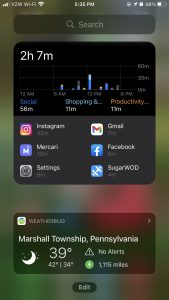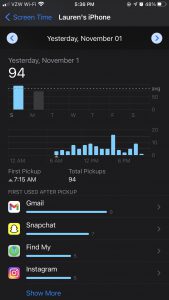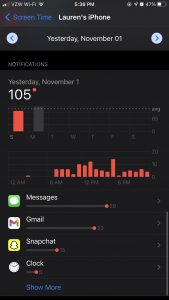For our data journal assignment, I transferred data from my iPhone’s battery and activity pages and extracted data from my SugarWod app (my gym’s tracking app). Here is the link to the spreadsheet:
https://docs.google.com/spreadsheets/d/1Xh992dbhlvU-JV-2-xfVM744YW9924r0JEVBFdVG3Go/edit?usp=sharing
When I started this assignment, I initially was interested in looking at my google searching data. However, when I looked into accessing it, I learned that my data tracking was turned off; I remembered that a friend of mine had turned it off last year when I was trying to purchase airline tickets. She told me that google or other websites are able to see what flights you are looking for, and therefore raises the price. Because I didn’t have any google data that I could access, I turned to data that apps and my iPhone collect.
The data I looked at I seemed to have varying levels of access; for example, my SugarWod app enables me to download a spreadsheet of my data with one tap: it is seamlessly emailed to me. However, my iPhone data is available in pictorial or numerical form but I could not find a way to download it into a condensed, spreadsheet form. Therefore, I decided to transfer the pictorial data into a spreadsheet. I will also attach images to show how this data is oftentimes shown in bar charts, and is now a “widget” feature of the new iPhone update. This data is intelligible, as when you click on different bars on the chart it highlights the specific data it contains, but it is bothersome to me that I am not quite sure why the iPhone gathers this data if I don’t allow apple to collect my data and I’m personally unable to download it. Conversely, after realizing through this exercise that SugarWod easily exports data, I’m thinking that this feature was central in the creation of the app. However, I am uncertain who has access to this data. It is not clear to me whether SugarWod collects this data or even if my gym, which I “join” through the app, is able to see all of the content in my app.
The design of iPhone data collection is very vague in categorizing data which makes me question the data holes that are in this design. For example, my iPhone tells me that on October 27th, I had 6.7 hours of activity: about 3 hours with my screen on, about 4 hours with my screen off. But, there are 12 hours in a day. What is happening for the rest of those hours, if they aren’t included in the “screen off” activity. There are inherently holes in this data collection, but it is presented as if it depicts the whole story of iPhone activity.
In terms of time and space, I was a bit unsettled when realizing that the iPhone collects “pickups;” to me, this data wasn’t only symbolic of when I use my phone, but indicates when I am asleep and waking up each day. It inherently reveals my daily routine in a very convoluted way.
I knew that my data from SugarWod was inherently “measurable:” I input numbers that correspond with my workouts. However, I realized from my iPhone data that some things are measurable that I did not think to be possible (I’m thinking about the pickups specifically here).
I am drawn to this idea of “pickups” in depicting my daily routine; a visualization that I would be interested in creating would be documenting different locations in which I picked up my phone. Each pick up could be a dot on a map, with the size indicating the amount of times the phone was picked up in that location. The iPhone shows a bar chart as a timeline of this, showing what times of day pickups occur most frequently.
I feel like the “pixelated person” that emerges from the data is one of “hard data.” I recently listened to a podcast that talked about the presence of “hard data” vs “soft data” with soft data being tied to an individual’s “less quantifiable self,” like their emotions. The types of data that I looked at are easily comparable to others (many people have iPhones and workout); however, I’ve been thinking about how, being in a sport that is largely driven by “data” in times, I was always told to not let my numbers define me. I think these questions loop back to our conversation of what constitutes a person, and if data availability has come to define that.



Hi both Ailee and Zack! Thank you for your comments!
To Ailee- I’m going to play the devil’s advocate here and question why our society feels that data = accountability. I’m wondering about the historical structures in place that caused us, today, to feel that progress “has to be tracked” or it’s not “real.” Do we have to create data in order to prove accountability? Thanks for raising such important points and making me realize that there is an absurd amount of swimming data that exists about me…..haha.
To Zack- I’ve also been thinking a lot about the questions you’ve raised. I would totally recommend listening to the “Design Lab with Bon Ku” podcast on October 29th, which featured Giorgia Lupi. She’s my favorite data visualist and her discussions of hard and soft data influenced my post. In terms of your questions about “not letting numbers define you,” I’ve found that whether it be my grades or my times, a lot of the time the end result or the “data” doesn’t represent the entire journey. You’re essentially summarizing months of hard work into a single number. I’m think that rather than “not letting numbers define you,” I should have been more clear in saying that I don’t let these singular, “all encompassing” numbers define me. As Ailee referenced in her comment on my post, our swim team collects data on EVERYTHING. It’s crazy. But, there are some things that might not be 100% reflected in these data, such as our moods, thoughts, emotions, and social life that impact our performance. I hope this helps, and I would love to continue this discussion in class sometime!!
HI RENIE!
I was very intrigued by your comparison of “measurable” and “immeasurable” data. I think something that I keep overlooking in our discussions of data and data collection is the element of awareness. Being on the swim team during this pandemic, as we both know, has brought us some unique challenges as well as taught us some very important lessons about accountability, connection to purpose, and the drastic difference between self-reported data and data recorded by someone else.
At school, we are so used to having our times read out to us, our weight numbers given to us, and our seasonal improvement tracked for us through progression sets. Literally all we have to do is show up for practice- even THAT in itself is data- and the staff takes care of the rest. I did not realize this until all 30 of us were spread across the world, all in different quarantine situations, and being given workouts to complete on our own. Per NCAA rules, the only the way for the coaches to monitor our progress was through our own, voluntarily self-reported data.
I think of Renie’s pick-ups as the “immeasurable” but still somehow measured data that we generate without being aware of it at school; we don’t have to do any active, conscious work to collect it. The coaches do it for us. Then, the “measurable” SugarWod data, I guess, would be the self-reported workout data all of us were tasked to submit to the coaches during the quarantine.
A HUGE factor of self-reported data, we’ve quickly learned, is trust. Who knows- all 30 of us could have been laying in bed completely making up our workout numbers and submitting them. Self-reported data, no matter who sees it, assumes every time that whatever the reporter inputs is accurate and truthful. It’s really a scary thing, especially when you’re the one who has to interpret it based on this blind assumption. It gives an unnerving amount of power and control of the “narrative” to the data reporter(s).
THIS is why I think Renie’s pick-ups are extremely fascinating. This kind of weird, trivial data bypasses completely the aspect of awareness/self-reporting and consequently shifts the power entirely to the collectors. I mean, the best way to get the “truth” about someone is to observing them when they think no one’s watching, right? And then it becomes our turn to be unnerved. I never really thought about how WHO inputs the data matters, but this post (along with our shared experience of the remote Princeton swim team) opened my eyes to the unique power dynamics that arise from different methods of collection. Thanks Ren
Hi Lauren, I was really captivated by your discussion of hard versus soft data, where “hard data” tends to refer to something directly measurable and “soft data” implies that the information was collected through the quantification of qualitative observations. As a sociology major, this has been a tension that has really plagued my independent research, as differentiating between the two and assessing their external validity has proven to be challenging at times. Like you point out in your post, this is obviously super relevant to the concept of the “pixelated person”. I was wondering if you had any additional insight into the exact determination of this threshold and the liminality of the categories. Can a datum be both “hard” and “soft”?
You also briefly touched on the reiterative nature of datafication, in the sense that it often creates the reality that it represents. At the end of your post, you stated that you were “always told to not let [your] numbers define” you. Does this pertain exclusively to sports or do you apply this philosophy more generally? If so, what are some strategies you have implemented in your daily life to help dismantle this reliance on data as a benchmark of performance? I’ve attempted to separate data, particularly my grades, from my conceptions of identity in the past, but I’ve struggled to do so due to its social integration. Have you similarly found this challenging? I’d love to hear if this class has helped you further unravel this association between data and personhood.